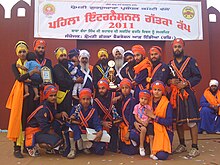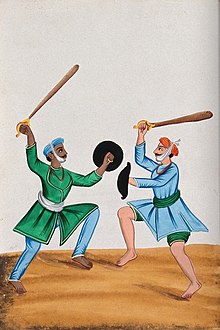Gatka
This articleneeds additional citations forverification.(January 2018) |
 | |
| Focus | Weaponry |
|---|---|
| Country of origin | Punjab regioninIndiaandPakistan |
| Olympic sport | No |
| Part ofa serieson |
| Sikhism |
|---|
 |
Gatka(Gurmukhi:ਗੱਤਕਾ;Shahmukhi:گَتّکا;Hindi:गतका;Urdu:گَتکا) is a form ofmartial artassociated primarily with theSikhsof thePunjaband other related ethnic groups, such asHindkowans.[1][2]It is a style ofstick-fighting,withwooden sticksintended to simulateswords.[3]ThePunjabiname,gatka,refers to the wooden stick used and this term might have originated as a diminutive of a Sanskrit word,gada,meaning "mace".[4]
The stick used in Gatka is made of wood and is usually 91–107 cm (36–42 in) long, with a thickness of around 12.7 mm (0.50 in). It comes with a fitted leather hilt, 15–18 cm (5.9–7.1 in) and is often decorated withPunjabi-style multi-coloured threads.[2]
The other weapon used in the sport is a shield, natively known asphari.It is round in shape, measuring 23 by 23 centimetres (9.1 in × 9.1 in), and is made of dry leather. It is filled with either cotton or dry grass to protect the hand of player in case of full contact hit by an opponent.[2]
Gatka originated in the Punjab in the 15th century. There has been a revival during the later 20th century, with an International Gatka Federation was founded in 1982 and formalized in 1987, and gatka is now popular as a sport orsword danceperformance art and is often shown duringSikh festivals.[5]
History
[edit]

Gatka's theory and techniques were taught by theSikh gurus.It has been handed down in an unbroken lineage ofustāds(masters), and taught in manyakharas(arenas) around the world. Gatka was employed in the Sikh wars and has been thoroughly battle-tested. It originates from the need to defenddharam(righteousness), but is also based on the unification of the spirit and body:miri piri). It is, therefore, generally considered to be both a spiritual and physical practice.[6]
After theSecond Anglo-Sikh War,the art was banned by the new British administrators of India in the mid-19th century.[7][better source needed]During theIndian Rebellion of 1857,theSikhsassisted the British in crushing the mutiny. As a consequence of this assistance, restrictions on fighting practices were relaxed, but the Punjabi martial arts which re-emerged after 1857 had changed significantly.[citation needed]The new style applied the sword-fighting techniques to the wooden training-stick. It was referred to asgatka,after its primary weapon. Gatka was used mainly by theBritish Indian Armyin the 1860s as practice for hand-to-hand combat. The Ministry of Sports and Youth Affairs of the Government of India has included Gatka, with three otherindigenousgames, namelyKalaripayattu,Thang-TaandMallakhamba,as part of the plannedKhelo India Youth Games2021, expected to be held inHaryana.[8]This is a national sports event in India.[9]
TheIOAplans to include Gatka in the 37thNational Games of Indiain 2023 held inGoa.
Competition
[edit]Khel(meaning "sport" or "game" ) is the modern competitive aspect of gatka, originally used as a method of sword-training (fari‑gatka) or stick-fighting (lathi khela) in medieval times. Whilekhelgatka is today most commonly associated with Sikhs, it has always been used in the martial arts of other ethno-cultural groups. It is still practiced in India and Pakistan by theTanoliandGujjarcommunities.[10][2]
Influence on Defendu
[edit]TheDefendusystem devised by CaptainWilliam E. Fairbairnand Captain Eric Anthony Sykes borrowed methodologies from Gatka,jujutsu,Chinese martial artsand "gutter fighting". This method was used to train soldiers in close-combat techniques at theCommando Basic Training CentreatAchnacarryinScotland.[11]
See also
[edit]- Angampora
- Banshay
- Bataireacht
- Bōjutsu
- Commandos (United Kingdom)
- Hola Mohalla
- Indian martial arts
- Jūkendō
- Kalaripayattu
- Kendo
- Kenjutsu
- Krabi–krabong
- Kuttu Varisai
- Mardani khel
- Nihang
- Paika akhada
- Pehlwani
- Shastar Vidya
- Silambam
- Silambam Asia
- Special Operations Executive(SOE)
- Sqay
- Tahtib
- Thang-ta
- Varma kalai
- World Silambam Association
References
[edit]- ^Yavari, Musa (26 February 2019)."'گتکا ہماری ثقافت ہے اور ہم نے اسے قائم رکھنا ہے'"[Gatka is our culture and we have to preserve it].BBC Urdu(in Urdu).Shergarh, Punjab.Archivedfrom the original on 3 April 2019.Retrieved28 February2019.
- ^abcdSadaqat, Muhammad (17 March 2019)."Gatka a centuries old art of self-defence".DAWN.Retrieved7 October2021.
- ^Donn F. Draegerand Robert W. Smith (1969).Comprehensive Asian Fighting Arts.Kodansha International Limited.
- ^Ananda Lal,The Oxford companion to Indian theatre,Oxford University Press (2004),ISBN9780195644463,p. 129.
- ^"Sikh martial art 'Gatka' takes the West by storm".The Hindu.New Delhi.Press Trust of India.27 July 2006. Archived fromthe originalon 30 September 2007.Retrieved23 May2024.
- ^Singh, Pashaura; Louis E. Fenech (March 2014).The Oxford Handbook of Sikh Studies.OUP Oxford. p. 459.ISBN978-0-19-969930-8.
- ^"Ancient but Deadly: 8 Indian Martial Art Forms and Where You Can Learn Them".The Better India.10 January 2017.Archivedfrom the original on 9 June 2020.Retrieved11 April2019.
- ^"Sports Ministry approves inclusion of four indigenous games in Khelo India Youth Games".The Hindu.PTI. 20 December 2020.Archivedfrom the original on 21 January 2022.Retrieved21 January2022.
- ^Hussain, Sabi (13 September 2018)."Khelo India: Khelo India to become Khelo India Youth Games with IOA on board".The Times of India.Archivedfrom the original on 21 January 2022.Retrieved21 January2022.
- ^"Gatka is our culture and we have to maintain it".BBC.26 February 2019.Archivedfrom the original on 3 April 2019.Retrieved8 March2020.
- ^Peter-Michel, Wolfgang (2011).The Fairbairn-Sykes fighting knife: Collecting Britain's most iconic dagger.Atglen, Pennsylvania: Schiffer Military History.ISBN978-0764337635.
External links
[edit]- Nanak Dev Singh Khalsa & Sat Katar Kaur Ocasio-Khalsa (1991)Gatka as taught by Nanak Dev Singh, Book One – Dance of the Sword(2nd Edition). GT International, Phoenix, Arizona.ISBN0-89509-087-2
- "The Fairbairn Sykes Fighting Knives".X-Daggers.Retrieved21 January2022.
- Olaf Janson (2015)Fairbairn–Sykes fighting knife:The famous fighting knife used by British commandos and SOE during WW2.Gothia Arms Historical Society
